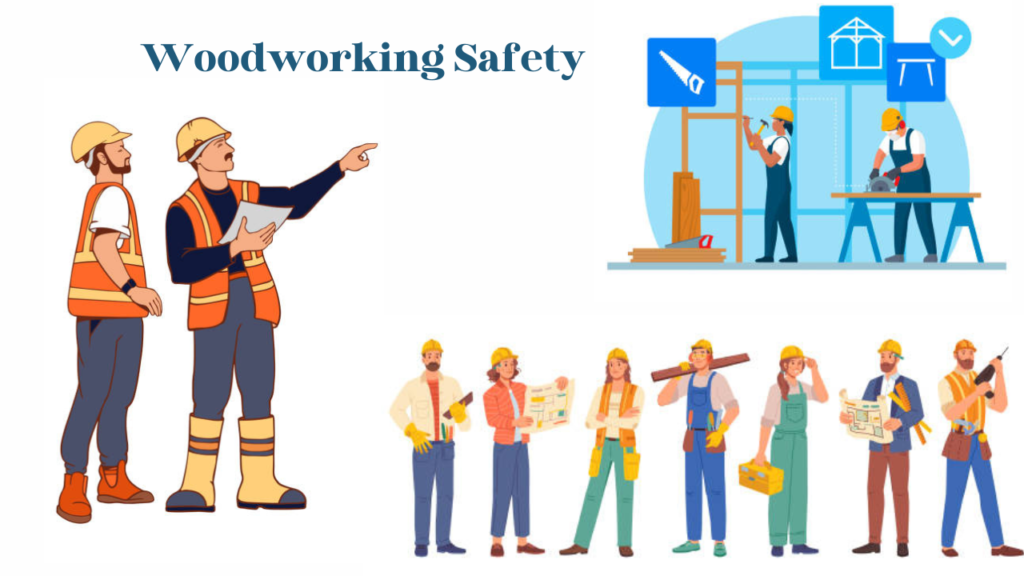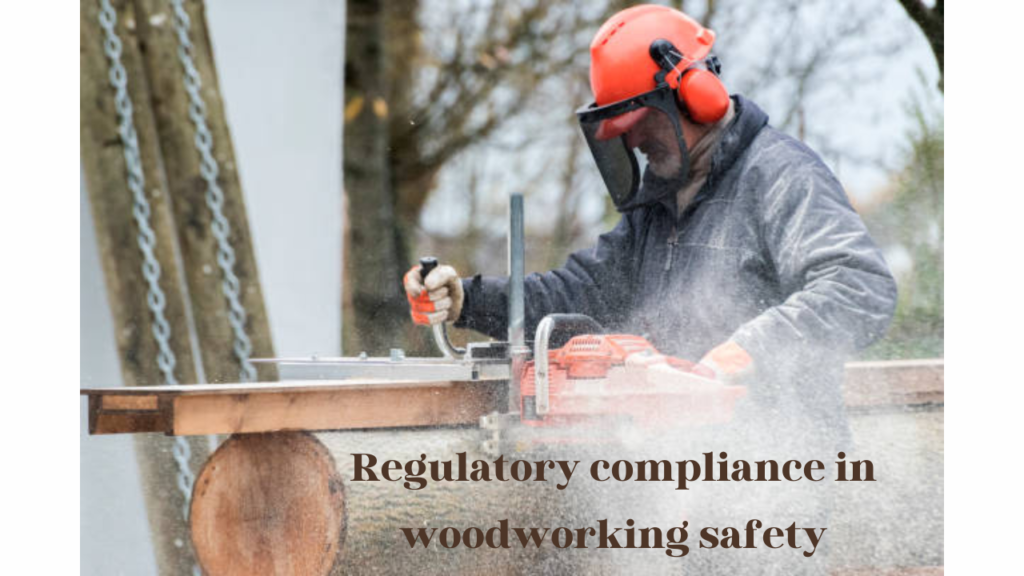
- Introduction
- A. Importance of safety in Ensuring Safety in Woodworking
- B. Risks associated with woodworking
- II. Essential Safety Gear
- A. Eye protection
- B. Ear protection
- C. Respiratory protection
- D. Hand protection E. Foot protection
- III. Safe Workspace Setup
- A. Proper lighting
- B. Adequate ventilation
- C. Organized work area
- D. Secure flooring
- IV. Proper Tool Usage
- A. Understanding tool manuals
- B. Maintaining tools regularly
- C. Safe handling practices
- V. Material Handling Safety
- A. Proper lifting techniques
- B. Storing materials securely
- C. Identifying and handling hazardous materials
- VI. Woodworking Machinery Safety
- A. Training on machinery operation B. Regular machine maintenance C. Emergency shut-off procedures
- VII. Fire Safety
- A. Fire extinguisher placement
- B. Safe storage of flammable materials
- C. Emergency evacuation plan
- VIII. First Aid Preparedness
- A. First aid kit essentials
- B. Training in basic first aid
- C. Emergency contact information
- IX. Creating a Safety Culture
- A. Employee training programs
- B. Regular safety meetings
- C. Reporting and addressing safety concerns
- X. Regulatory Compliance
- A. Understanding local safety regulations
- B. Obtaining necessary certifications
- XI. Woodworking Safety Resources
- A. Online safety courses
- B. Safety guidelines from reputable sources
- C. Woodworking safety forums and communities
- XII. Case Studies
- A. Real-life incidents and lessons learned B. Implementing safety measures based on case studies
- XIII. Importance of Continuous Learning
- A. Evolving safety standards
- B. Staying updated on safety trends
- XIV. Conclusion
- A. Recap of key safety measures
- B. Encouragement for prioritizing safety
Ensuring Safety in Woodworking: A Comprehensive Guide
Ensuring Safety in Woodworking, a craft that brings creations to life through the transformation of wood, is not without its risks. Whether you’re a seasoned professional or just starting, prioritizing safety in woodworking is paramount. In this comprehensive guide, we’ll delve into essential safety practices, from the right gear to maintaining a safe workspace and handling tools and materials responsibly.
I. Introduction

A. Importance of safety in woodworking
Safety should never be an afterthought in woodworking. The precision and creativity of this craft can be overshadowed by accidents if proper precautions aren’t taken. This section explores why safety should be a top priority for every woodworker.
B. Risks associated with woodworking
Understanding the potential risks is the first step in safeguarding yourself in the workshop. From sharp tools to potentially harmful materials, we’ll identify the key hazards that woodworkers face.
II. Essential Safety Gear
A. Eye protection
The eyes are particularly vulnerable in woodworking. Learn about the types of eye protection available and why they are crucial for preventing injuries.
B. Ear protection
Woodworking can be noisy, and prolonged exposure can lead to hearing damage. Discover the importance of ear protection and the options available for woodworkers.
C. Respiratory protection
Wood dust and fumes can pose respiratory risks. Explore the various respiratory protection measures to keep your lungs safe during woodworking projects.
D. Hand protection
Working with sharp tools requires adequate hand protection. We’ll discuss the types of gloves suitable for different tasks and how they contribute to a safer woodworking experience.
E. Foot protection
Heavy materials and sharp objects on the floor can pose risks to your feet. Find out how the right footwear can provide the necessary protection in the workshop.
III. Safe Workspace Setup
A. Proper lighting
Good visibility is essential for precision and safety. Learn how proper lighting can contribute to a well-lit and safer workspace.
B. Adequate ventilation
Woodworking often involves dust and fumes. Discover the importance of ventilation and how to ensure a well-ventilated workspace.
C. Organized work area
A cluttered workspace is a breeding ground for accidents. Get tips on organizing your work area for efficiency and safety.
D. Secure flooring
Slips and falls can happen in any workshop. Explore how the right flooring choices can minimize the risks of accidents.

IV. Proper Tool Usage
A. Understanding tool manuals
Every tool comes with a manual for a reason. Learn why it’s crucial to understand and follow tool manuals for safe operation. Ensuring Safety in Woodworking.
B. Maintaining tools regularly
Regular maintenance is key to tool longevity and safety. We’ll discuss simple yet effective maintenance routines for your woodworking tools.
C. Safe handling practices
Proper tool handling is a fundamental aspect of safety. Explore the best practices for safely using and storing your woodworking tools.
V. Material Handling Safety
A. Proper lifting techniques
Back injuries are common in Ensuring Safety in Woodworking. Discover the right way to lift and handle materials to protect your back from strain.
B. Storing materials securely
A well-organized material storage system is essential for safety. Learn how to store materials securely to prevent accidents and damage.
C. Identifying and handling hazardous materials
Some materials in woodworking can be hazardous. We’ll discuss how to identify and safely handle these materials in your projects.
VI. Woodworking Machinery Safety
A. Training on machinery operation
Operating machinery requires skill and knowledge. Explore the importance of proper training before using woodworking machinery.
B. Regular machine maintenance
Machinery malfunctions can lead to accidents. Learn about the significance of regular machine maintenance in ensuring a safe working environment.
C. Emergency shut-off procedures
In case of emergencies, knowing how to quickly shut off machinery can prevent serious injuries. Discover the emergency shut-off procedures for woodworking machines.
VII. Fire Safety
A. Fire extinguisher placement
Fire safety is often overlooked in woodworking. Find out where to place fire extinguishers and how to use them effectively.
B. Safe storage of flammable materials
Woodworking involves materials that can be flammable. Learn how to store these materials safely to minimize fire risks.
C. Emergency evacuation plan
Being prepared for emergencies is crucial. Develop an emergency evacuation plan for your workshop to ensure everyone’s safety.
VIII. First Aid Preparedness
A. First aid kit essentials
Accidents can happen, and having a well-equipped first aid kit is vital. Explore the essential items to include in your woodworking first aid kit.
B. Training in basic first aid
Knowing how to administer basic first aid is essential for every woodworker. Learn the basics to be prepared for any unexpected situations.
C. Emergency contact information
Having emergency contact information readily available can save precious time in critical situations. Discover the key contacts every woodworker should have on hand.
IX. Creating a Safety Culture
A. Employee training programs
For workshops with multiple participants, training programs are essential. Learn how to establish effective employee training programs to instill a safety culture.
B. Regular safety meetings
Communication is key to maintaining a safe environment. Explore the benefits of regular safety meetings and how they contribute to a safer workspace.
C. Reporting and addressing safety concerns
Encouraging an open dialogue about safety concerns is crucial. Discover the importance of reporting and addressing safety concerns promptly.
X. Regulatory Compliance
A. Understanding local safety regulations
Different regions have varying safety regulations. Understand the local safety regulations relevant to your woodworking activities.
B. Obtaining necessary certifications
Certifications add credibility to your commitment to safety. Explore the certifications available for woodworkers and how to obtain them.
XI. Woodworking Safety Resources
A. Online safety courses
The internet offers valuable resources for learning woodworking safety. Explore online safety courses to enhance your knowledge and skills.
B. Safety guidelines from reputable sources
Reputable sources provide comprehensive safety guidelines. Discover where to find reliable safety guidelines for woodworking.
C. Woodworking safety forums and communities
Connect with fellow woodworkers to share experiences and learn from others. Joining safety forums and communities can provide valuable insights.
XII. Case Studies
A. Real-life incidents and lessons learned
Examining real-life incidents helps prevent similar accidents. Explore case studies to understand the lessons learned and how to implement safety measures.
B. Implementing safety measures based on case studies
Learn how to apply the insights gained from case studies to enhance safety in your own woodworking practices.
XIII. Importance of Continuous Learning
A. Evolving safety standards
Safety standards evolve over time. Stay updated on the latest standards to ensure your woodworking practices align with the current safety norms.
B. Staying updated on safety trends
Embrace continuous learning to stay informed about emerging safety trends in woodworking.
XIV. Conclusion
A. Recap of key safety measures
Summarize the essential safety measures discussed throughout the guide to reinforce their importance.
B. Encouragement for prioritizing safety
Conclude with a motivational message encouraging woodworkers to prioritize safety in every aspect of their craft.
XV. FAQs
A. What are the most crucial safety gear items in woodworking?
Woodworking involves various hazards, and essential safety gear includes eye protection, ear protection, respiratory protection, hand protection, and foot protection.
B. How often should woodworking tools be inspected for safety?
Regular inspections are crucial for tool safety. Check your tools before each use and conduct a more thorough inspection at least once a month.
C. Are there specific regulations for woodworking safety?
Yes, regulations vary by location. It’s important to understand and comply with local safety regulations relevant to woodworking activities.
D. Can online courses effectively teach Ensuring Safety in Woodworking?
Absolutely! Online courses provide accessible and valuable resources for learning Ensuring Safety in Woodworking, offering flexibility for woodworkers to enhance their knowledge at their own pace.
E. What steps can be taken to create a safer woodworking environment?
Creating a safer woodworking environment involves proper training, regular safety meetings, organized workspaces, and the use of appropriate safety gear. Prioritize safety in every aspect of your woodworking practices.
Pingback: Essential Tips for Safe and Sustainable Woodworking in Your workshop - woodyly